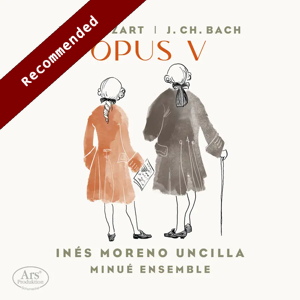
Opus V
Contents listed after review
Inés Moreno Uncilla (harpsichord)
Minué Ensemble
rec. 2024, Tonstudio Waldenburg, Switzerland
Reviewed as a digital download with PDF booklet from note1music
Ars Produktion ARS38660 [65]
It is notable how views on composers and compositions can change with time. A famous example is Beethoven’s Eroica symphony. It received its premiere together with a symphony in the same key by Anton Eberl, which was judged the better of the two by the audience. Today, Eberl has been reduced to the status of a ‘minor’ composer, whereas Beethoven’s Eroica is one of his most frequently performed works.
Something comparable has happened to Johann Christian Bach. Today, very few music lovers or performers reckon him among the great composers of the 18th century. Wolfgang Amadeus Mozart had a very different opinion on him. When he heard in 1782 that the youngest Bach son had died, he commented: “What a loss to the musical world!”.
They had met in London, when Mozart, together with his father and his sister, visited England on their tour across Europe. At the time, Bach was one of the main figures in English music life, and as Mozart’s reputation had preceded him, a meeting between the two was inevitable. This resulted in a mutual affection, which lasted as long as the two lived. That is all the more remarkable as in later years Mozart was often highly critical of colleagues, and never hid his distaste for their music. Johann Christian Bach was one of the exceptions.
In 1766 Bach published a set of six keyboard sonatas as his Op. 5. At that time, the Mozarts had already left London, but Wolfgang had seen them and probably also played them or heard Bach play them. Three of these sonatas inspired him to make arrangements for keyboard, two violins and bass, although with some help from his father. Most of the string parts are in Wolfgang’s handwriting, whereas Leopold wrote out the keyboard parts and the figured bass. Mozart added tutti sections between phrases of Bach’s original keyboard parts, which results in a succession of solo and tutti sections.
As the three concertos are too short to fill a disc, performers have to find some additional material. The most logical option is the one chosen by Inés Moreno Ancilla; she plays the remaining three sonatas from Bach’s Op. 5. As Mozart had selected the sonatas 2, 3 and 4, in between the sonatas 1, 5 and 6 are played. Some may consider the music of Johann Christian Bach superficial. That is probably largely due to performances which don’t do it real justice, and that has much to do with the choice of instruments.
Keyboard music from the decades around 1750 causes quite some problems in this regard. The harpsichord still played a major role, especially among amateurs who could not afford to buy the modern fortepiano, alongside the clavichord and – especially in England – the spinet. The edition of the Op. 5 sonatas was the first in England to refer to the fortepiano on the title page, but the harpsichord was mentioned first. Interestingly, an edition of around 1775 mentions the two instruments in reverse order, probably reflecting the growing popularity of the fortepiano in the 1770s.
In the sonatas by Bach, the choice of the harpsichord seems justified. An alternative may be the square piano, which was quite popular in England. In my collection I have a recording on a copy of a Walter fortepiano of 1795. That is definitely the wrong instrument. Here, on the harpsichord, Bach’s sonatas all of a sudden reveal their qualities. Listen to the brilliant allegro assai, the first movement of the Sonata V; it receives a sparkling performance, and the harpsichord is the perfect tool. JC Bach superficial? The grave that opens the Sonata VI is of great expressive depth, and is followed by a fugue, which shows that Bach had learned a thing or two from his father.
In the case of the Mozart arrangements, the choice of the harpsichord is also the most logical one. Too often his keyboard music is indiscriminately described as ‘piano music’, even by representatives of historical performance practice. These concertos have been recorded on fortepiano, even on copies of that famous Walter of 1795. However, it was only in the early 1770s that Mozart owned a fortepiano. There can be no doubt that he arranged Bach’s sonatas with the harpsichord in mind.
These concertos are quite well-known and available in several recordings, also on harpsichord. I don’t know all of them, but I dare to say that this is one of the best recordings of these works. This is chamber music, but the performances are vigorous, both on the harpsichord and by the strings. The fast movements are full of energy, the slow movements are performed with much subtlety and feeling. The balance between them is as it should be. The sonatas by Johann Christian Bach show the composer’s true qualities. More of his keyboard works played this way would be most welcome.
This recording seems to be the debut of Inés Moreno Uncilla and the Minué Ensemble. They have made the best possible start of what one may hope to be a successful career.
Johan van Veen
www.musica-dei-donum.org
twitter.com/johanvanveen
Buying this recording via a link below generates revenue for MWI, which helps the site remain free.


Contents:
Wolfgang Amadeus Mozart (1759-1791)
Concerto for keyboard, two violins and bass in D (KV 107,1 / 21b,1)
Concerto for keyboard, two violins and bass in E flat (KV 107,3 / 21b,3)
Concerto for keyboard, two violins and bass in G (KV 107,2 / 21b,2)
Johann Christian Bach (1735-1782)
Sonata for keyboard in B-flat, Op 5,1 (Warb A 1)
Sonata in E, Op 5,5 (Warb A 5)
Sonata in C minor, Op 5,6 (Warb A 6)

















